
The BMW 5 Series is an executive car manufactured and marketed by BMW since 1972, succeeding the New Class Sedans, and currently in its seventh generation.

BMW M62 is a naturally aspirated V8 petrol engine which was produced from 1995 to 2005. A successor to the BMW M60, the M62 features an aluminium engine block and a single row timing chain.

The BMW E39 is the fourth generation of the BMW 5 Series range of executive cars, which was manufactured from 1995 to 2004. It was launched in the sedan body style, with the station wagon body style introduced in 1996. The E39 was replaced by the E60 5 Series in 2003, however E39 Touring models remained in production until May 2004.

The fifth generation of the BMW 5 Series executive cars consists of the BMW E60 and BMW E61. The E60/E61 generation was produced by BMW from 2003 to 2010 and is often collectively referred to as the E60.

The BMW M54 is a naturally aspirated straight-6 DOHC petrol engine produced from 2000 to 2006. It was released in the E53 X5 and is the replacement for the M52 engine. The S54 is the equivalent high performance engine, used in the E46 M3, the Z3 M Coupé/Roadster and the E85/E86 Z4 M. The BMW M56 SULEV engine is based on the M54.

The BMW N62 is a naturally aspirated V8 petrol engine which was used in BMW cars from 2001–2010. It also remained in small-scale production for the Morgan Aero until 2019. The N62 is the world's first engine to use a continuously variable-length intake manifold, and BMW's first V8 to feature variable valve lift.
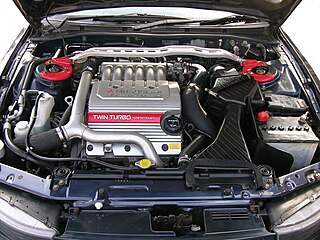
The Mitsubishi 6A1 engine is a series of piston V6 engines from Mitsubishi Motors, found in their small and medium vehicles through the 1990s. They ranged from 1.6 to 2.5 L in size, and came with a variety of induction methods and cylinder head designs and configurations.
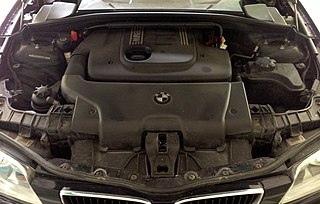
The BMW M47 and Rover Group M47R are straight-4 Diesel engines. Variants were manufactured by BMW from 1998 to 2007. BMW gradually adopted high-pressure common rail fuel injection systems over the lifetime of the M47.

Alpina Burkard Bovensiepen GmbH & Co. KG is an automobile manufacturing company based in Buchloe, in the Ostallgäu district of Bavaria, Germany that develops and sells high-performance versions of BMW cars. Alpina works closely with BMW and their processes are integrated into BMW's production lines, and is recognized by the German Ministry of Transport as an automobile manufacturer, in contrast to other performance specialists, which are aftermarket tuners. The Alpina B7 is produced at the same assembly line in Dingolfing, Germany, as BMW's own 7 Series. The B7's twin-turbo 4.4-litre V8 is assembled by hand at Alpina's facility in Buchloe, Germany, before being shipped to BMW for installation, and the assembled vehicle is then sent back to Alpina for finishing touches.

The BMW S85B50 is a naturally aspirated V10 petrol engine which replaced the BMW S62 V8 engine in the M5 model and was produced from 2005–2010. It was both BMW's first and only production V10 engine, and the first petrol V10 engine to be available in a production sedan (saloon).

Prince is the codename for a family of straight-four 16-valve all-aluminium gasoline engines with variable valve lift and variable valve timing developed by BMW and PSA Peugeot Citroën. It is a compact engine family of 1.4–1.6 L in displacement and includes most modern features such as gasoline direct injection and turbocharger.
6HP is ZF Friedrichshafen AG's trademark name for its six-speed automatic transmission models for longitudinal engine applications, designed and built by ZF's subsidiary in Saarbrücken. Released as the 6HP 26 in 2000, it was the first six-speed automatic transmission in a production passenger car. Other variations of the first generation 6HP in addition to the 6HP 26, were 6HP19, and 6HP 32 having lower and higher torque capacity, respectively. In 2007, the second generation of the 6HP series was introduced, with models 6HP 21 and 6HP 28. A 6HP 34 was planned, but never went into production.
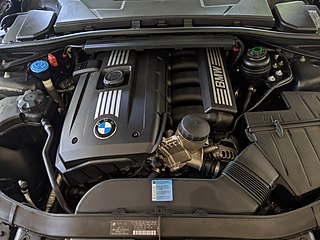
The BMW N52 is a naturally aspirated straight-6 petrol engine which was produced from 2004 to 2015. The N52 replaced the BMW M54 and debuted on the E90 3 Series and E63 6 Series.

The BMW N53 is a naturally aspirated straight-6 petrol engine which was produced from 2006 to 2013. The N53 replaced the BMW N52 and was released in 2006 in the post-facelift E60 5 Series.
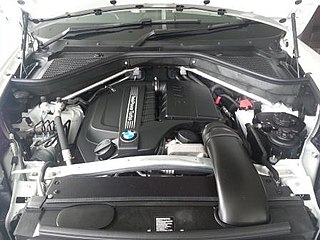
The BMW N55 is a turbocharged straight-six petrol (gasoline) engine that began production in 2009. The N55 replaced the BMW N54 engine and was introduced in the F07 5 Series Gran Turismo.
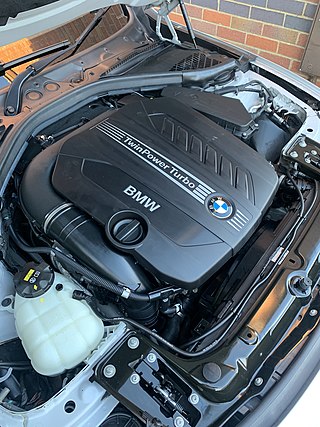
The BMW N57 is a family of aluminium, turbocharged straight-6 common rail diesel engines. The engines utilize variable geometry turbochargers and Bosch piezo-electric injectors. The engine jointly replaced the M57 straight-6 and M67 V8 engines. In 2015 the N57 started to be replaced with the B57 engine, beginning with the G11 730d.
The BMW N43 is a naturally aspirated four-cylinder petrol engine which was sold from 2006 to 2013. It replaced both the BMW N46 and BMW N45 engines. However the N43 was not sold in countries with high sulfur fuel, therefore the N45/N46 engines remained in production alongside the N43.
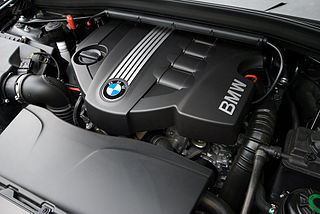
BMW N47 is a four-cylinder common rail diesel engine that has many improvements over its predecessor, the M47. In 2014 it was replaced with the B47. The USA market never received B47 engine. The only B engine in the US for a diesel was a B57 in 2018 540d. The newest 4 cylinder diesel in the US was N47TU.
The ZF S6-37 is a 6-speed manual transmission manufactured by ZF Friedrichshafen AG. It is designed for longitudinal engine applications, and is rated to handle up to 370 newton-metres (273 lbf⋅ft) of torque.
The ZF S6-53 is a 6-speed manual transmission manufactured by ZF Friedrichshafen AG. It is designed for longitudinal engine applications, and is rated to handle up to 600 newton-metres (443 lbf⋅ft) of torque.
















